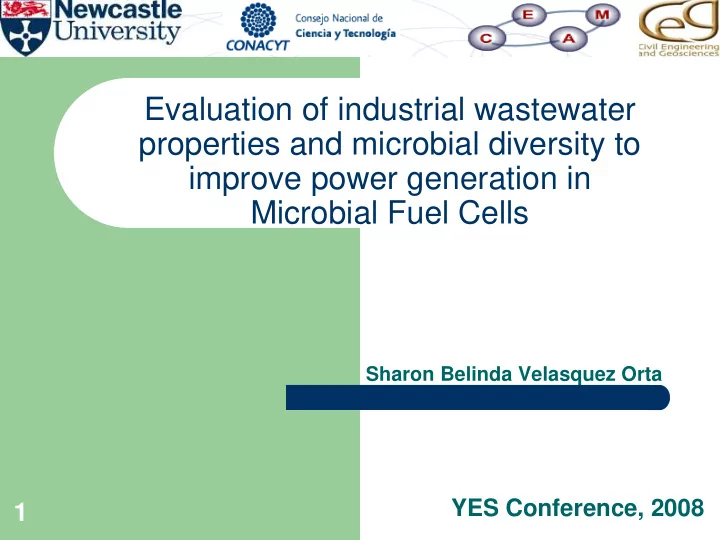

Evaluation of industrial wastewater properties and microbial diversity to improve power generation in Microbial Fuel Cells Sharon Belinda Velasquez Orta YES Conference, 2008 1
Contents � Introduction � Aim and objectives � Methodology and experimental set-up � Analysis of Results � Conclusions � Work being developed 2
Introduction Environmental Issues Cost Pressures � Global Warming � UK energy costs will come under great pressures due to increased import � Carbon emissions are going to carry an increasing price tag � Customers are going to pick � Wastewater discharges suppliers that focus on sustainability 3
I ntroduction Wastewater Treatment Systems Physical Biological Wastewater Secondary Primary Treatment Inlet Energy Treatment (AD) High C hemical MFC O xygen D emand Tertiary Discharge Treatment Chemical I mages taken from www.rdn.bc.ca
How do Microbial Fuel Cells (MFC) work? Treated Inside an MFC lives a water colony of bacteria under e - anaerobic conditions. These Anaerobic Reactor (C+catalyst) Cathode bacteria are fed sewage which they oxidize to create H + Anode (C) a flow of current. MFCs Air consist of an anode and cathode similar to a conventional battery. Proton Sewage Exchange Membrane 5
Mechanism Mediators or CO 2 direct contact O � 6 CO 2 + 24 H + + 24e - C 6 H 12 O 6 + 6 H 2 Wastewater Microorganisms Electrons Electrode (Anode) Protons Electrical Circuit 6 O 2 + 24H + + 24 e - � 12 H 2 O Oxygen Electrons Electrode (Cathode) Water 6
Methanogenesis 7
Differences with Anaerobic WT � Conventional � Microbial Fuel Cells – Hydrolisis – Hydrolisis – Fermentation – Fermentation – Methanogenesis – Shuttle of electrons � Methane and CO 2 � Lower quantities of production Methane production � Biogas production to be � Electricity generation processed for electricity directly from anaerobic generation processes � T>20 o C � T < 20 o C 8
Logan, 2007 and Christensen, 2007 Designs
Substrate effect in MFC � Wastewaters: domestic, food processing, swine wastewater and beer processing (Du et al, 2007) . � Wastewater characteristics affect: – rate of organic matter degradability – microbial ecosystem � rate of bacterial electron transfer � overall MFC process efficiency � Why study wastewater characteristics? – To increase the understanding of the mechanisms affecting electron shuttling rates – To explore for alternatives for MFC control and optimization according to the type of wastewater used 10
Aim and Objectives “To study the substrate effect in MFC” � To compare the effect of using different industrial wastewaters in bioelectricity generation :Bakery, brewery, paper and dairy � To determine the relationship between: wastewater characteristics Power Output bacterial diversity 11
Methodology DNA extraction, 8 batch MFC+ controls DGGE, Bionumerics Inoculum: Anaerobic Sludge Fix sample and store -20 o C NO MEDIATOR Current Subs 1: Diary WW Subs 2: Brewery WW Polarization Subs 3: Beer WW COD, VFA, pH Subs 4: Paper WW 12
Methodology: Wastewaters Characteristics Wastewater Dilution (in COD s Anions (ppm) pH Conductivity μ S/cm tap water) (mg/L) (NaCl or HCl) Fluoride: 0 Diary WW 50/200 700 7 832 Chloride: 138 Phosphate: 6 Sulphate: 31 Fluoride: 12 Bakery WW 13/200 651 7 79.6 Chloride: 11 Phosphate: 6 Sulphate: 8 Fluoride: 1.3 Brewery WW 1.3/200 661 7 180.6 Chloride: 5 Phosphate:3 Sulphate:10 Fluoride: Paper WW 200/200 600 7 1397 Chloride: 189 Phosphate: Sulphate:241.3
Results: current production 300 Last Batch COD removal: MFC 1 - DAIRY 1 Diary WW: 620 mg/L, 81 % Brewery WW: 515 mg/L 68% MFC 2 - DAIRY 2 Bekary WW: 620 mg/L 85 % MFC 3 - BREWERY 1 250 Paper WW: 460 mg/L 80 % MFC 4 - BREWERY 2 MFC 5 - BAKERY 1 MFC 6 - BAKERY 2 MFC 7 - PAPER 1 200 MFC 8 - PAPER 2 -3 / mA Current x 10 150 6 5 7 4 3 1 2 100 50 0 14 0 50 100 150 200 250 300 Time (hr)
Results: polarization 600 60 500 50 Power Density / mWm-2 400 40 Voltage / mV 300 30 200 20 Diary Wastewater 100 10 Brewery wastewater Bakery Wastewater Paper Wastewater 0 0 0 50 100 150 200 250 300 Current Density / mAm-2
Results: process parameters VFA concentrations COD removal 100 180 Diary Wastewater Diary Wastewater 160 Brewery Wastewater Brewery Wastewater Bakery Wastewater Bakery Wastewater 80 Paper Wastewater Total Volatile Fatty Acids / mgdm-3 140 Paper Wastewater 120 % COD removal 60 100 80 40 60 40 20 20 0 0 260 270 280 290 300 310 320 260 270 280 290 300 310 320 Time / hr Time / hrs
Why some WW are not producing electricity? Electrochemical processes are being favoured in the reactor containing paper wastewater Effect of different conductivities 1. Effect of different types and quantities of bacteria 2. Effect of electron shuttle mediators 3.
7100± 300 μ S/cm 1. Results: conductivity 180 μ S/cm 1390 μ S/cm 832 μ S/cm
2. Results: bacteria
Anode e - e - e - e - 3. Results: e - shuttle mediators Mediator Red - Ox e - e - Bacteria 20
Are electron shuttle properties transferable? Conditioning all reactors for one batch with paper wastewater and use again its corresponding wastewater.
green: paper ww, blue: brewery ww, red: dairy ww Cyclic voltammetry 22
Conclusions � All MFC systems achieved high COD removal rates although only MFC fed with paper wastewaters developed a high current output. � MFC microbial biofilm communities differed according to the wastewater type. � Current output differences were due to the presence of an electron shuttle compound. � Conductivity partially limited current output in all cases. � The mediator was in some cases transferable to be used in MFC reactors with different wastewaters.
Merci !
Recommend
More recommend